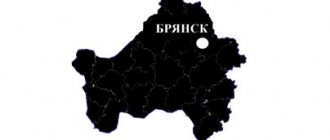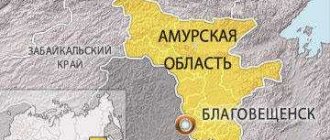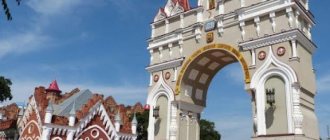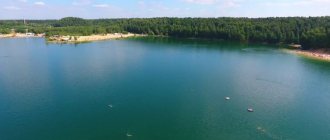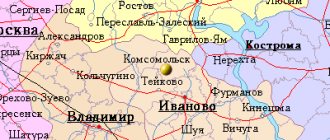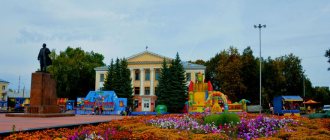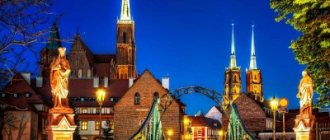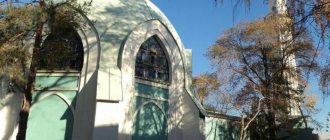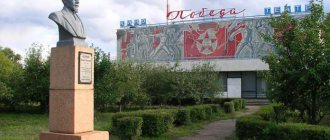Skovorodino
(Amur region)
OKATO code:
10249501
Founded:
1908
City since:
1927 City of district subordination (Skovorodinsky district of the Amur region)
Center:
Skovorodinsky district
The city was formerly called:
| Serpentine | 1908 | 1909 |
| Never-I | 1909 | 1911 |
| Rukhlovo | 1911 | 1938 |
| Telephone code (reference phone) | |
| 41654***** | 91-2-92 |
Deviation from Moscow time, hours:
6
Geographic latitude:
53°59′
Geographic longitude:
123°56′
Altitude above sea level, meters:
400 Sunrise and sunset times in the city of Skovorodino
OUR HOMELAND IS SKOVORODINO...
The goals have been set, the deadlines have been determined. Electromechanics Puchkov, Volkov, Yakimenko, Smolin, Sheveleva and others took direct part. After a ten-year break, on April 1, 1970, the Skovorodinsky branch was re-established, which was initially located on Yuzhny Lane. Chertkov was appointed head of the communications department, Sarapulov was appointed head of the distance. In August 1974, the chief engineer of the Trans-Baikal Railway, Comrade Gennady Arsentievich Timofeev, came to Skovorodino. Due to the increase in cargo traffic on many long haul routes, it was decided to open new separate points - checkpoints. On the Taldan-Skovorodino section, 10 points had to be built in 20 days, and at the start of construction there was no material or equipment in the distance, so Comrade. V.N. Pestretsov was obliged to install semaphores. The head of the Skovorodino station was obliged to find old two-axle cars in the required quantity and install them in the planned coordinates. The distance of civil structures makes the necessary repairs for work and housing. After the meeting, none of the managers believed in the reality of these deadlines, but after 19 days the distance team reported on the completion of this task. They worked day and night, in two shifts. I can’t believe it, but they worked at exactly the same pace. They worked for a common cause. Because they knew that the result would meet all expectations - it was aimed at the well-being of people! In our city, many streets bear the names of famous people. On the pages of our newspaper we have already written about where the names of streets familiar to us from childhood came from. That many of them were previously called differently. But on the eve of such an important event for all of us as the Jubilee of the region, it’s not a sin to repeat the history of your small homeland! — Lazo Street: named after the Hero of the Civil War Lazo Sergei Georgievich. S.G. Lazo (1894-1920), commander of the Transbaikal Front (1918), member of the CPSU (b) since 1918, leader of the partisan movement in the Far East against the interventionists and White Guards. — Sakhina Street: previously called Sakhinskaya Street. Bears the name of the commander of the Red Guard detachment, Pavel Naumovich Sakhin. Sahin P.N. fought in Transbaikalia under the leadership of S.G. Lazo. In 1919, after the liquidation of the Transbaikal Front, a detachment in a small echelon advanced along the railway to the east to connect with the partisans of the Amur region. Before reaching the village. Rukhlovo, a few miles away, the detachment fell into a White Cossack ambush. The train was stopped. After an unequal battle, the survivors were disarmed, and the detachment commander P.N. Sahin. was buried in a mass grave near the old church; only 65 people were buried there. In 1936, when the old church burned down, the mass grave was opened, the coffin with the remains of P.N. Sakhin. and 64 people were reburied in the city cemetery. — Kalinin Street: named after Mikhail Ivanovich Kalinin (1875-1946), a leader of the Communist Party and the Soviet state. He has been a member of the RSDLP (b) since 1989. He was arrested many times for his revolutionary activities. Participated in the organization and training of fighting squads in Petrograd. In December 1905 he was a member of the regional combat headquarters. After the October Revolution of 1917, he was elected to the Petrograd City Duma and elected city mayor. Since 1919 - member of the Central Committee of the RCP (b) and Chairman of the All-Russian Central Executive Committee. Since 1925 - member of the Politburo of the Central Committee of the All-Union Communist Party of Bolsheviks. 1938-1946 — Chairman of the Presidium of the Supreme Soviet of the USSR. Hero of Socialist Labor - 1944. On July 31, 1923, while traveling through the cities of Siberia and the Far East, he visited Rukhlovo. In memory of this event, on April 4, 1970, a memorial plaque was installed at the railway station building. — Vasilevsky Street: named after Marshal of the Soviet Union, twice Hero of the Soviet Union Alexander Mikhailovich Vasilevsky (1895-1977). He began his military service during the First World War. In 1937 he graduated from the Military Academy of the General Staff, and since 1937 - head of the department of the General Staff of the Red Army. During the Great Patriotic War he was a Representative of major operations of the Soviet troops. In 1943 he received the title of Marshal of the Soviet Union. In 1944 - the title of Hero of the Soviet Union. In February 1945, Vasilevsky A.M. appointed commander-in-chief of Soviet troops in the Far East. Under his leadership, the regrouping of Soviet troops was carried out, the Manchurian strategic operation to defeat the Kwantung Army was planned, prepared and carried out (August 9 - September 2). For carrying out the Manchurian operation Vasilevsky A.M. received the title of twice Hero of the Soviet Union. On August 17, 1945, from the Skovorodino Western Communications Center, Marshal Vasilevsky transmitted a radiogram to General Yama-de Otoza, commander of the Kwantung Army. In memory of this event, the street of the military town of Skovorodino-5 was named after Marshal Vasilevsky. Vasilevsky A.M. signed the Japanese surrender agreement. After the end of the war, he was Chief of the General Staff, Deputy Minister of the USSR Armed Forces, Minister of the USSR Armed Forces (1949-1953), and First Deputy Minister of Defense of the USSR (1954-1956). Awarded: eight Orders of Lenin, two Orders of the Red Banner, Order of Suvorov 1st degree, Order of the Red Star, twice awarded the Order of Victory. Urn with the ashes of Vasilevsky A.M. located in the Kremlin wall. - Vorovsky Street: previously the street was named after Vorovsky - in honor of Voclav Votslavovich Vorovsky (1871-1923), comrade-in-arms of V.I. Lenin. to create and strengthen the Bolshevik Party. After the February Revolution of 1917, he headed the foreign representation of the Central Committee of the RSDLP (b), located in Stockholm. Since November 1917 - Ambassador of Soviet Russia to the Scandinavian countries (Sweden, Denmark, Norway). He took an active part in the preparation of the first congress of the Comintern. In 1921-1923 headed the Soviet mission in Italy. Participant of the Genoa (1922) and Lausanne (1922-1923) international conferences. He headed the Soviet delegation in Lausanne. Died at the hands of an assassin on May 10, 1923. — Dzerzhinsky Street: formerly there was Gorny Lane. Renamed in 1977 in honor of Dzerzhinsky Felix Edmundovich (1877-1926), he was a revolutionary, Soviet statesman and party leader. Active participant in the Polish and Russian revolutionary movement. For revolutionary activities he was repeatedly sentenced to imprisonment and exile. Delegate to a number of congresses and conferences of the RSDLP, one of the leaders of the armed uprising in Petrograd in 1917. In December 1917, at the suggestion of Lenin, he was appointed Chairman of the Cheka (All-Union Extraordinary Commission). Since 1921 - People's Commissar of Railways, retaining the posts of Chairman of the Cheka and People's Commissar of Internal Affairs (1919-1920). — Mukhina Street: previously called Mukhinskaya, named in honor of Fyodor Nikanorovich Mukhin. Mukhin F.N. (1878-1919) - member of the RSDLP (b) since 1904. Participant of the revolutionary movement of 1905-1906. in Transbaikalia. Since 1906 he worked in the Social Democratic organization of the Amur region. Since 1917 - member of the Blagoveshchensk Council of Workers' and Soldiers' Deputies, deputy chairman of the military organization. Since January 1918 - Chairman of the Executive Committee of the Blagoveshchensk Council. In 1918-1919, he was the organizer and leader of the underground Bolshevik organization in the Amur region. On March 8, 1919, he was arrested in Blagoveshchensk and shot dead by a Cossack convoy. — Postysheva Street: previously called Bezymyannaya, named after Pavel Petrovich Postyshev. Postyshev P.P. (1897-1940) - a prominent party and statesman. For active participation in the revolution of 1905-1907. was convicted and exiled to hard labor in the Irkutsk province. He was one of the organizers of the partisan movement in the Far East and actively participated in the creation of the Red Army. After the end of the civil war, he worked as First Secretary of the Kyiv Provincial Committee, Secretary of the Central Committee of the Communist Party (Bolsheviks) of Ukraine. At the 12th Party Congress he was elected as a candidate member of the Politburo of the Central Committee of the All-Union Communist Party of Bolsheviks. — Skovorodina Street: named after the first chairman of the Rukhlovsky village council, Skovorodin Afanasy Nikolaevich (1881-1920), who was shot by the Japanese interventionists. Previously, the street was called Skovorodinskaya. — Surnin Street: named after the Hero of the Soviet Union Georgy Ivanovich Surnin (1918-1991). — Yubileinaya Street: formerly Bazarnaya Street. — Amur Partisan Street: formerly Remeslennaya Street. — Kommunisticheskaya Street: formerly Militseiskaya Street. — Magistralnaya Street: formerly Strelkovaya Street. — Mira Street: formerly Poperechnaya Street. — Tayozhny Lane: formerly Fabrichny Lane. — Neversky Lane: formerly Zavodskoy Lane. — Zhivopisny Lane: formerly Rassypnoy Lane. — Zvezdny Lane: formerly Trudny Lane. — Severny Lane: formerly Bazovy Lane. — Mirny Lane: formerly Nadezhdinsky Lane. — Solnechny Lane: formerly Bolnichny Lane. - PMS - 225: microdistrict "Novy", the name was assigned in 1989. — Victory Street: formerly Nagornaya Street, renamed in 1985. Read the ending in the following issues. The editors would like to thank all participants for their assistance in preparing the material. Information: local history museum named after. P.A. Florensky. Photo: group “Skovorodino” (Odnoklassniki).
Map
| Skovorodino: maps |
Skovorodino: photo from space (Google Maps) Skovorodino: photo from space (Microsoft Virtual Earth)
| Skovorodino. Nearest cities. Distances in km. on the map (in brackets along roads) + direction. Using the hyperlink in the distance , you can get the route (information courtesy of the AutoTransInfo website) | |||
| 1 | Magdagachi | 136 (268) | SE |
| 2 | Tynda | 139 (175) | WITH |
| 3 | Zeya | 219 (309) | IN |
| 4 | Deadlock (Trans-Baikal Territory) | 265 () | Z |
| 5 | Mogocha | 274 (333) | Z |
| 6 | Neryungri | 302 (403) | WITH |
| 7 | Chulman (Republic of Sakha (Yakutia)) | 324 () | WITH |
| 8 | Shimanovsk | 333 (405) | SE |
| 9 | Tsiolkovsky | 373 () | SE |
a brief description of
The city is located on permafrost, in the upper reaches of the river. Bolshoi Never, on the left slope of the valley, 669 km northwest of Blagoveshchensk. Railway node
Information about the city of Skovorodino on the Russian Wikipedia website
Historical sketch
It arose in 1908 as a village during the construction of the Trans-Siberian Railway and was first called Zmeiny, then renamed Never-I (based on its location on the Bolshoi Never River), and in 1911 - Rukhlovo.
Since 1927, the city of Rukhlovo received its modern name in 1938 in honor of the first chairman of the local Council A.N. Skovorodin (1890-1920), who died here.
Economy
In Skovorodino there are enterprises for servicing the BAM.
Food industry - bakery, dairy.
Culture, science, education
Hydrological station, laboratory of the Tyndinskaya permafrost station.
Museums, galleries, exhibition halls
Albazinsky Museum of Local Lore 676065, Amur region, Skovorodinsky district, village.
Albazino, st. School Phone(s) Website: https://www.museumamur.ru/ Skovorodino Regional Museum named after. P.A. Florenskogo 676014, Amur region, Skovorodinsky district, Skovorodino, st. Pobeda, 28 Phone(s)
| Population by year (thousands of inhabitants) | |||||||
| 1931 | 3.3 | 1996 | 14.1 | 2007 | 9.9 | 2015 | 9.3 |
| 1939 | 19.9 | 1998 | 13.9 | 2008 | 9.8 | 2016 | 9.3 |
| 1959 | 15.1 | 2000 | 13.6 | 2010 | 9.5 | 2017 | 9.3 |
| 1970 | 11.4 | 2001 | 13.5 | 2011 | 9.6 | 2018 | 9.2 |
| 1979 | 13.0 | 2003 | 10.6 | 2012 | 9.5 | 2019 | 9.1 |
| 1989 | 13.8 | 2005 | 10.1 | 2013 | 9.5 | 2020 | 8.9 |
| 1992 | 14.1 | 2006 | 10.0 | 2014 | 9.4 | 2021 | 8.7 |
Government of the Amur Region
At the beginning of the 20th century, in the valley of the Bolshoy Never River, an expedition of engineer Anosov discovered a large gold deposit. One after another, gold mines opened. To connect them with the regional center, a road was built - the Dzhalinda tract. In 1908, a winter hut appeared on the left bank of the Bolshoi Never River, which was a spacious hut, cut down from rough-hewn logs from the outside. It was from this simple building that the history of the Amur city - Skovorodino - began. A year later, construction of a station village began on this site. The first settlers called it Snake - after the name of one of the hills on which there were many snakes. Officially, the station was named Never-1. It should be noted that the name of the river and station of the same name is distorted. In the 19th century, the Evenks called the river Bolshoy Liver, from the Evenki “levere” - “swamp”.
In August 1911, while inspecting the construction of the Amur Railway, the village of Never-1 was visited by the Minister of Railways, Sergei Vasilyevich Rukhlov, together with the Amur Governor-General. The minister donated 10,000 rubles for the construction of the church. In the same year, the village of Zmeiny was renamed Rukhlovo . The station remained Never-1.
In the 20s, Rukhlovo was a small village, in the northern part of which there were three small streets, and in the southern part there were only two buildings: a church and a priest’s house. In addition, there was a locomotive depot built in 1915. Only after the end of the civil war did the village of Rukhlovo begin to develop, a railway station was built, administrative buildings and residential buildings were erected.
On July 31, 1923, Chairman of the All-Russian Central Executive Committee M.I. visited Rukhlovo. Kalinin. Now one of the streets bears his name, and in April 1970 a memorial plaque was installed on the station building in memory of his arrival. In 1926, the Zeya district was formed, the center of which was the village of Rukhlovo, and on February 14, 1927, by a resolution of the Presidium of the All-Russian Central Executive Committee, it was given the status of a city.
In the same year, 1927, the first permafrost research station in the USSR was created here. In 1933-1934. A famous physicist, mathematician, philosopher, theologian, and literary critic, Pavel Aleksandrovich Florensky, worked at the experimental permafrost station. He was arrested and convicted under the notorious Article 58 (counter-revolutionary conspiracy) and exiled to the Far East to the Svobodnensky branch of BAMLAGA. In 1937, the scientist was shot in the Solovetsky camp. The works of Pavel Florensky made a huge contribution to the development of our region. , 1938 By decree of the Presidium of the Supreme Soviet of the RSFSR, the city of Rukhlovo was renamed Skovorodino in honor of the first chairman of the local village Council Afanasy Nikolaevich Skovorodin. By the early forties, the city's population was just under twelve thousand.
After the Great Patriotic War, the city continued to grow and develop. In the 60s The railway fleet switched to diesel traction, and the construction of automatic telephone exchanges and residential apartment buildings began.
Over the last decades of the 20th century, new dates appeared in Skovorodin’s chronicle: April 4, 1978, during a trip to the cities of Siberia and the Far East, the city was visited by the General Secretary of the CPSU Central Committee L.I. Brezhnev. 1980s — the first electric locomotives appeared in the locomotive depot. 1986 A railway bridge – viaduct – was built. 1994 - an Orthodox parish was formed in Skovorodino and an Orthodox church was built. March 28, 1996 – at a session of the city Council of Deputies, the charter and coat of arms of the city were approved.
The city, like the whole country, entered the 21st century with new plans and hopes. The old, wooden city is gradually giving way to modern quarters. In place of the old city, new high-rise buildings have grown up; the winding labyrinths of old streets and alleys have replaced the clear lines of new avenues, parks and squares, and playgrounds. The city continues to grow, the railway industry, gold mining industry, and private business are developing.
The material was prepared by the department of scientific information and use of documents of the State Institution of the Amur Region “State Archive of the Amur Region” based on the funds of the State Archive of the Amur Region
